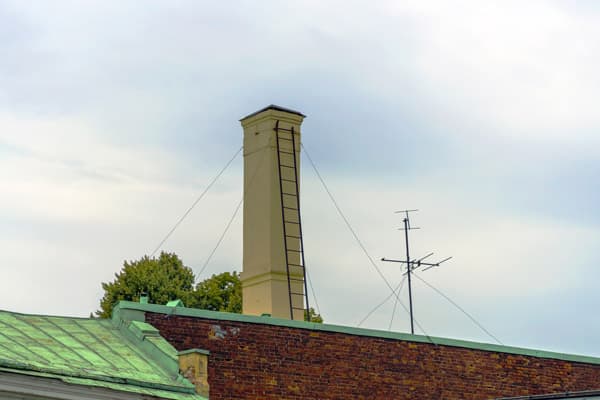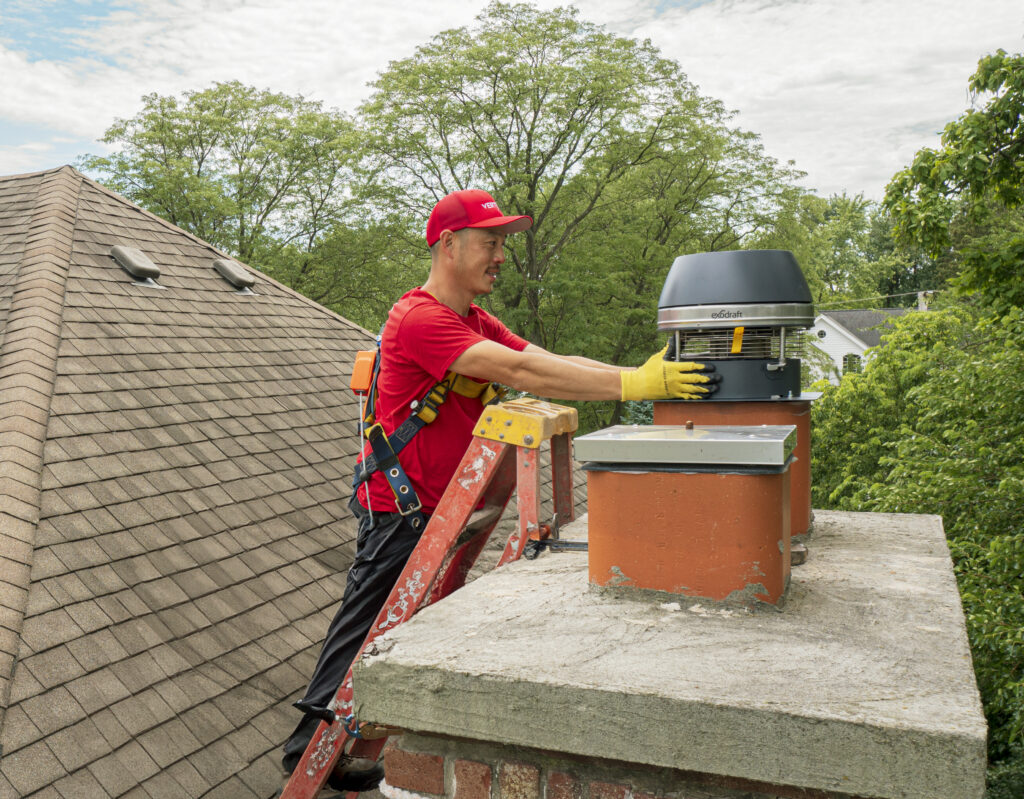
Leaning and separating chimneys from your house are signs of more serious problems. A leaning chimney indicates that your house has structural or foundation issues. Although not every circumstance is the same, a leaning chimney is a typical indication that your property is experiencing some form of foundation settlement and should be assessed by a qualified foundation repair professional.
A brick chimney can weigh more than 8,500 pounds, depending on its size. It is affixed to the rooftop and fastened to the ground. The force of gravity, however, can cause your house or chimney to fall under its weight if structural problems arise, causing significant property damage and perhaps even injuries.
A chimney may lean away from a house for a variety of reasons. Even though these reasons differ, leaning chimneys must be treated seriously and evaluated to identify the issue. Discover the causes of a leaning chimney and how you can fix it to stop it from causing further harm.

Causes of a Leaning Chimney
Bad Quality Chimney
A chimney has a good probability of developing a lean at some time and may suffer other damage if it is not built properly by expert masons or if subpar bricks and mortar are used.
Moisture Damage
The main cause of chimney problems is moisture, which ruins the masonry work. Even if the deterioration process doesn't start immediately, it is a matter of time until the house is severely damaged. Routine chimney maintenance guarantees preventative steps are done.
The winter's freezing and thawing cycles can cause the stored water to repeatedly expand and contract, causing movement that weakens the bricks after moisture has entered the brickwork. The material around the chimney may start to spill off, which is a warning indicator. Do routine inspections and prompt chimney masonry repairs to avoid a complete chimney collapse.
Masonry Damage
A chimney's balance can be thrown off and cause the upper part of it to slant if it has old and deteriorated bricks or missing brick-and-mortar parts.

Improper Footing
The footing at the structure's foundation is a crucial component of chimney construction. The best footings are made of stone or concrete buried deep enough to serve as a stable foundation for many years. Sadly, not all footings are built in this manner. There was frequently needed to be cement chimney footing in older homes. Chimneys can start tilting at some point if they don't have a foothold.
Earthquakes have severely damaged chimneys in several regions of the nation. Shifting and damage could happen anywhere if a chimney is not properly footed.
The chimney footing may crack if it is too shallow or narrow to support the weight of the chimney. Footings made of sub par materials are likewise more prone to cracking. A chimney that tilts frequently has a broken footing.
A footing not properly reinforced during construction may break, causing the chimney to lean to one side.
Your initial professional assessment should concentrate on the footing and the chimney structure when buying a house with an existing fireplace. In this manner, any required rebuilding or repairs can be finished before you use the item.
Leaning Chimney Warning Signs
Chimneys shouldn't lean to one side; they should stand tall and straight. If the fireplace is not centered inside the home, some builders will construct the chimneys to "tilt." The chimney can leave at the roof ridge thanks to offset brick courses, which gives the home a symmetrical aspect from the exterior. You may be certain that the chimney is tilting on purpose if the horizontal mortar joints are level.
Finding a leaning chimney can be challenging. If you can't tell by looking, keep an eye out for these indicators:
Gaps Between Chimney and the House
Look at the seam where the siding meets the chimney. An obvious indication that the chimney is tilting is if a crack has appeared. The issue is not fixed or stopped from worsening by filling the gap with insulation, masonry, or sealant; it is temporarily concealed.
Displaced Flashing
The chimney is fastened to the roofline with metal flashing. Additionally, it stops moisture from penetrating the chimneys and roof seams. Look to see if any metal flashing strips have come loose where the chimney meets the roof. It is a sign of soil settling and could damage attic water.
Off-centered Chimney
Go to the attic and inspect if the chimney is centered in its frame and if it runs into the interior. Are there bricks on either side of the entrance, or both? If so, the building is sagging as a result.
Leaning Chimney Repairs
Similar to other minor foundation repairs, a settling chimney repair is provided by nearby push-pier contractors. Steel foundation push piers are the most widely used fix for leaning chimneys. A chimney leaning or separating from the home can be stabilized or lifted back into position when the conditions are perfect using push piers that a foundation repair business has driven deep into the soil. While chimney repairs have different warranties, most foundation repairs have lifetime warranties.

Your leaning chimney is likely seen as a regular repair by an expert foundation repair company. It does not imply, however, that chimney repairs are simple. What tools and other equipment, such as an excavator, may or cannot be used to finish a leaning chimney repair depends on your home's foundation, whether or not a basement is close to the chimney, and the accessibility of the areas surrounding the chimney. But if there are no unanticipated situations, this repair ought to be able to be finished the same day. (When you start digging, you never know what you'll find!)
How to Know If a Chimney Needs to be Replaced or Repaired?
You should not need to rebuild your entire chimney if you are concerned about a leaning chimney. Your chimney brick and fireplace are generally intact and in good functioning order. A chimney care expert can quickly fix and touch up a few damaged bricks.
You might need to employ a mason to repair the brick if your chimney is settling due to old, deteriorating, or crumbling bricks. However, a specialist needs to be called immediately because of the height and weight of a detached chimney and the weakening of the bricks that make up a risky side of the house. You can decide whether you need a new chimney by consulting a mason or a foundation repair business.
The foundation repair business you hire to restore a leaning chimney will also be able to inspect the remaining foundation of your house if you discover cracked bricks continuing along the structure's walls after the chimney. However, even if your main issue is a chimney, a professional should never focus on one area of the foundation. Instead, any inspection should involve a complete assessment of the entire perimeter and foundation to ensure no more serious problems could harm your chimney and potentially harm other areas of your property.
Your chimney carries thousands of pounds. Therefore, you shouldn't ignore it when it begins to mimic the Leaning Tower of Pisa eerily. Tilted or leaning chimneys seriously endanger your safety and your home. The sooner a chimney issue is detected, the better. To keep your home safe and your fireplace maintained, you should arrange an inspection as soon as you notice the aforementioned leaning symptoms on your chimney.
Since 1985, we’ve helped thousands of homeowners with creosote cleaning and chimney maintenance. That’s why we are the most trusted chimney maintenance company in the Midwest. Contact us to speak to a specialist!
